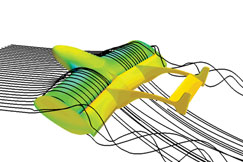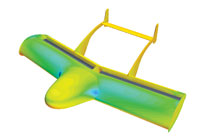For over a century mankind has devoted substantial resources toward achieving and improving flight. With the yearly threat of major wildfires and the ongoing conflicts in the Middle East as its primary focus, Propulsive Wing, LLC is developing unmanned aerial vehicle solutions for both domestic fire fighting support and military applications, covering a wide range of missions.
The Propulsive Wing is a completely new class of aircraft based on the integration of a cross-flow fan into the trailing edge of an airplane wing. The project began at Syracuse University with funding from NASA Glenn Research Center, and the technology is currently patent pending. Propulsive Wing LLC was founded to continue development and commercialize the platform as an unmanned airplane. Propulsive Wing is partnering with Elbridge, New York based engineering firm Allred & Associates, Inc. to accelerate this process.

Closeup of the polyhedral mesh around the cross flow fan
With its unique design, for a given wingspan, Propulsive Wings are able to carry up to three times the payload weight and ten times the internal payload volume of conventional systems. For this reason, the company calls its aircraft an aerial utility vehicle, or AUV for short. Propulsive Wing AUVs require shorter runways for take-off and landing (due to their extremely high lifting capability), generate low noise, and offer a high degree of user safety due to the elimination of external rotating propellers. This platform is applicable to many aircraft sizes ranging from small to large, unmanned and manned military, experimental, private and commercial passenger and cargo planes.
CFD was used throughout the design process to drive both aerodynamic and manufacturing decisions. For the current PW-4 prototype, which is currently undergoing flight-testing, the entire airframe was designed in CAD and modelled using STAR-CCM+ before fabrication even began. The ability of the application to import a CAD model and create a new computational mesh allowed for multiple design iterations to be completed within a short timescale.
In addition to complete aircraft simulations of the PW-4 prototype, CFD was also extensively used to simulate sub-systems. In the design of the cross-flow fan propulsion system, simulation results were used to optimize the blade and housing geometry. Using CFD, Propulsive Wing designed a custom carbon-fibre cross-flow fan with excellent mechanical and aerodynamic performance.

Propulsive wing is the first autonomous aerial utility vehicle (AAUV)
At the next level, simulations were performed to investigate the integration of the cross-flow fan within a propulsive airfoil. These studies looked at the effect of propulsive airfoil design parameters, for example fan speed and sizing, duct inlet and outlet locations, and exhaust angle, on lift, drag, and pitching moment. Also, power requirements in various configurations were calculated.
Full 3D unsteady simulations investigated the performance of the entire airplane. Understanding pitch stability characteristics and creation of a stable aircraft was a major technical hurdle. The Propulsive Wing configuration inherently involves complex coupling between the propulsion system and the wing pressure distribution, and can result in significant variations in pitching moment.
For example, if fan speed is increased, this in turn increases the flow rate, the result is not only higher thrust, but, depending on the exhaust angle, changes the pitch-up or pitch-down tendency of the airplane. Simultaneously, however, the fan also produces greater suction at the air inlet, which alters the pressure distribution on the wing surface, while creating a nose-up reaction due to the direction of rotation. Using STAR-CCM+, Propulsive Wing was able to successfully understand these relationships and create a stable flying aircraft.

Streamlines over the propulsive wing AAUV at a high angle of attack
The Propulsive Wing fits several niche applications where there currently is no solution. One is large payload, short duration sensor deployment for the military. Also, as the platform scales up, the large cargo and short takeoff and landing capabilities lend the AUV to missions where food, water, or other supplies need to be transported to remote or high altitude locations, both for military, as well as civilian emergency relief.
In addition to military use, one of the primary missions at Propulsive Wing is to develop the aircraft into a frontline component in the suppression of wildfires, which endanger people, wildlife, and agriculture. The goal is to supplement the use of large tanker-sized aircraft with swarms of smaller unmanned drones that will each drop up to 100kg of water or fire-retardant chemicals.
The short-field capability, compact size, and large cargo-carrying ability of the Propulsive Wing units, will allow rapid deployment from remote areas to help extinguish the thousands of small wildfires reported each year before they grow larger.
www.cd-adapco.com / www.propulsivewing.com

CFD is giving a lift to unmanned aircraft, writes Joseph Kummer






